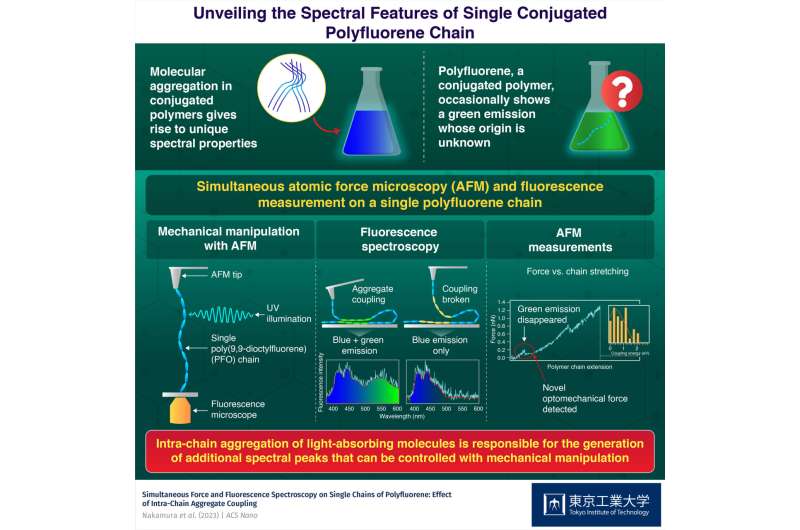This article has been reviewed according to Science X's editorial process and policies. Editors have highlighted the following attributes while ensuring the content's credibility:
fact-checked
peer-reviewed publication
trusted source
proofread
Unraveling the mechanism of green emission peaks in single polyfluorene chains

Molecular aggregates are clusters of small molecules held together by relatively weak forces believed to be originating from electronic interactions between the molecules. Owing to their exceptional photophysical properties, molecular aggregates find unique applications in many areas of technology and continue to be a subject of intense research. In fact, researchers have utilized molecular aggregates to engineer a variety of functional materials, biomedical tools, and nanodevices.
However, the phenomenon of molecular aggregation is not limited to small molecules alone. Individual polymer segment chains can also interact with one another and give rise to phenomena that are very similar to those found in molecular aggregates. One such example is polyfluorene, a conjugated polymer that, when excited by UV radiation or an appropriate electric field, emits a bright blue light in solution.
Despite being a well-researched polymer, the spectral peaks for polyfluorene have long been the subject of speculation. It turns out that, in addition to the blue emission, it occasionally also emits a green emission, the cause of which has been debated in the scientific community. One plausible explanation for the green emission is that it results from the occurrence of photooxidation reaction. However, there is also evidence that favors the interchain aggregation of chain segments as a cause.
A group of researchers from Tokyo Institute of Technology, Japan, led by Professor Martin Vacha, recently developed an innovative experimental protocol that aimed to resolve this knowledge gap. In their study published in ACS Nano, the researchers combined two microscopy techniques to perform precise photomechanical measurements in poly(9,9-dioctylfluorene) (PFO), a prototypical kind of polyfluorene.
First, a single PFO chain was chemically attached to the tip of an atomic force microscope (AFM) on one end and to a transparent substrate on the other end. Initially folded, the PFO chain was then stretched slowly by precisely controlling the position of the AFM tip.
As a result, the AFM could constantly gauge the amount of mechanical force required for the PFO chain to stretch. Simultaneously, the team measured the spectra of the light emitted by PFO upon UV illumination using a fluorescence microscope placed beneath the substrate. This helped them study the changes in emission spectrum of the PFO chain with mechanical stretching.
They observed a green emission band accompanying the blue emission band during the initial stage of stretching. The green emission band disappeared eventually as the folded chain was stretched and the intra-chain aggregates broke up, which was confirmed by the AFM measurements.
Explaining these observations, Prof. Vacha says, "Our work presents a direct evidence that the green emission band is observed due to intra-chain aggregation of PFO, which undergoes breakup on mechanical unfolding, and results in the disappearance of the green emission."
Additionally, the team also observed additional spectral features, suggesting a novel optomechanical force acting on some of the PFO chains. On further analysis, they found this force to be originating from the breakup of intra-chain aggregate coupling upon UV illumination. The nature of this coupling was determined through precise analyses.
Prof. Vacha highlights, "The force by which the aggregate was coupled and the length for which the coupling was effective revealed that this optomechanical force results from van der Waals interactions and excitonic coupling."
These pioneering techniques could find intriguing applications in a variety of fields, including energy conversion in molecular motors or the nano-mechanical manipulation of molecular properties in polymer chains and molecular nanofibers.
More information: Tomonori Nakamura et al, Simultaneous Force and Fluorescence Spectroscopy on Single Chains of Polyfluorene: Effect of Intra-Chain Aggregate Coupling, ACS Nano (2023). DOI: 10.1021/acsnano.2c09773
Journal information: ACS Nano
Provided by Tokyo Institute of Technology





















